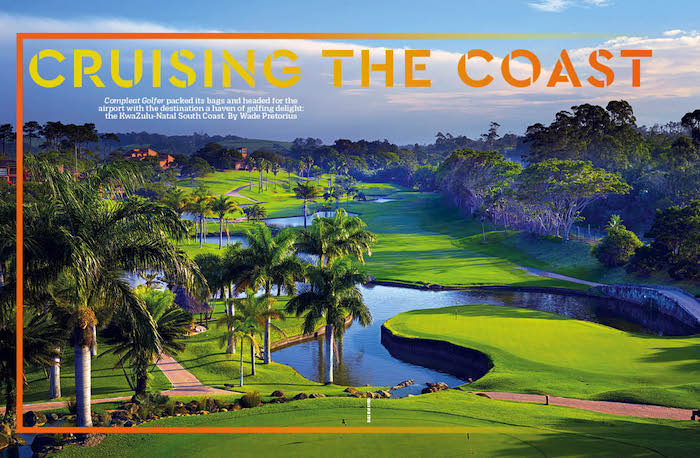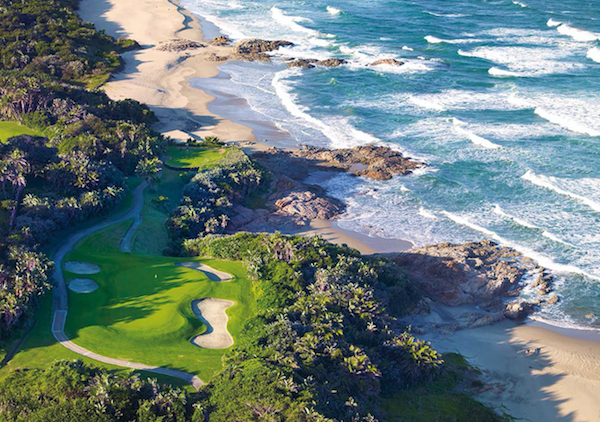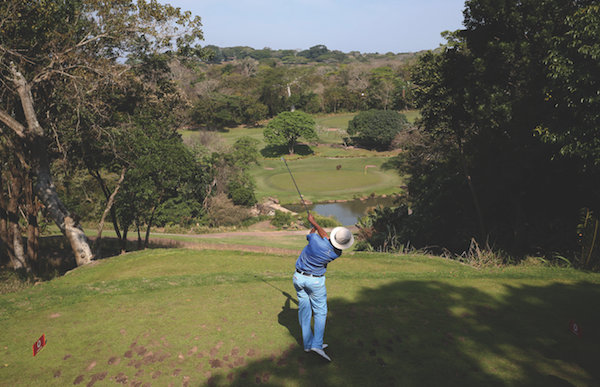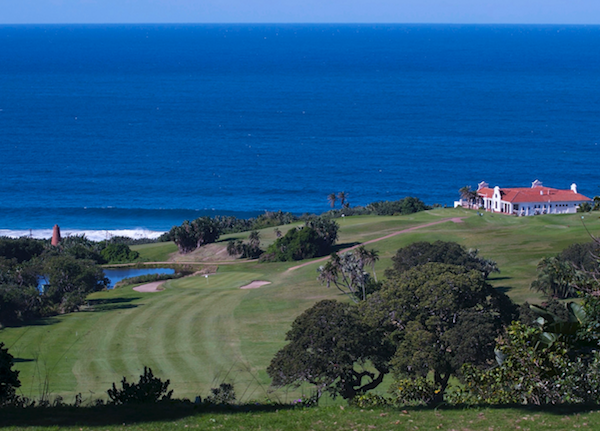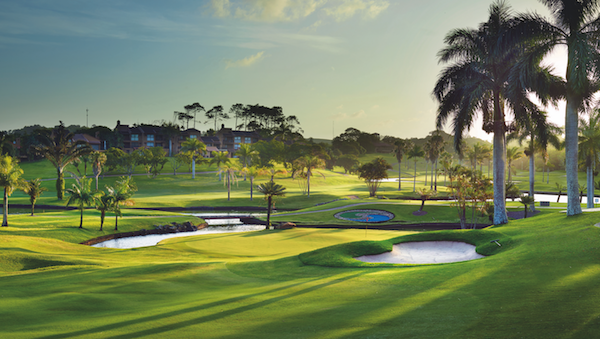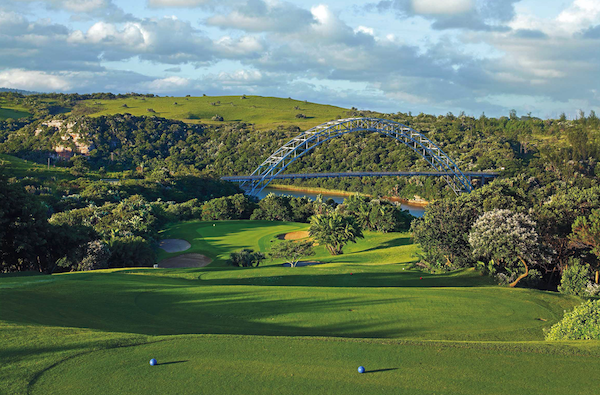Compleat Golfer packed its bags and headed for the airport with the destination a haven of golfing delight: the KwaZulu-Natal South Coast, writes WADE PRETORIUS in the February issue.
When the subject of a road trip down the South Coast came up, it would be ‘fake news’ to suggest there wasn’t a scramble for the two spots on offer. There are few greater pleasures for an avid golfer than packing clubs into a travel bag and heading off for a tour; it’s one of those times when there’s no way to humbly accept that having golf as your job does not have a downside.
Bred in the Eastern Cape and working in Cape Town, I’d never hit a ball on this stretch of land, but after gathering some intel from friends I quickly realised we were in for a treat. This is the story of the Compleat road trip.
Day one: Southbroom Golf Club
Established in 1938, the course has undergone constant improvements through the years to keep up with modern demands. The view from the 1st tee is a taste of what you are in for – a well-manicured course that isn’t overly long, but requires accuracy and a number of pauses to take in the sights.
We raced through the opening holes, leaving birdies out there for the late-afternoon starters, before pausing shortly before the 4th hole. It’s one of the most discussed holes, and you can see why. I loved the way the 3rd allows you a little glimpse into the beauty that lies just around the corner as you make your way on to the par-three’s tee box (more of that hole in our signature selection on pages 65 and 66).
The 5th plays away from the ocean and provides an opportunity to drive the green. It may look easy, but as we found out, the tiered green is ready to contribute to your three-putt tally in double-quick time.
The 11th and 13th are two more holes that deserve praise, with both featuring water to protect the green. The 11th is a par-three which uses water and elevation – a theme that would run throughout the trip – to protect par, with the 13th a short par-four that will test your ability to make good decisions. Rip a driver and avoid the right danger and a two-putt birdie awaits, but there’s more than enough merit to suggest a long-iron and wedge in to take the water out of play. Next time you’re up on the tee, you can make that call.
It’s a fun course, one where egos are checked at the entrance as you settle into holiday mode for the duration of your stay.
Off course: Not quite off course, but the pub area is welcoming and friendly, so do end your round there. Derek and Sheena James are superb hosts and their on-course shop will take you by surprise with it’s vast array of stock.
Day two: Selborne Golf Estate
The estate was a Jersey cow stud farm before it came up for sale in 1979 and was bought by Denis Barker, who carried on running his Fayden Jersey Stud farm before turning to work on the golf course.
His efforts created a masterpiece par-72 layout that hosts the Sunshine Tour every year. For the average player, it is a wonderful test from start to finish, with all 14 clubs needed for the undulating fairways and water throughout.
The course was in excellent shape and its pristine layout quite a contrast to the dense, indigenous forest that surrounds it.
Having 36 holes lined up, it was an early start with the dew glistening down the 1st fairway. It could be seen as just another high-praise cliche, but arriving at the 3rd is the start of a stretch as good as you’ll find. It is a par-five played to a blind dogleg left that runs steeply downhill towards the water. Most will lay up, leaving a pitch played off a downhill lie up towards a large putting surface. Take par and enjoy the scenery as you move to the stroke-nine par-three 4th.
Arguably the most demanding shot on the entire course, the two-tiered green with no miss in play will put pressure on your swing dynamics. For our round, the pin was located on the left, making a miss left of that almost an immediate double. Fortune favoured me on this occasion, as a light draw caught the slope perfectly and the ball rolled at a leisurely pace towards the cup. A hole-in-one eluded me, but a tap-in birdie was more than enough with so much trouble on offer.
More elevation is up next as you play down the par-four 5th to a valley fairway on a hole where the wind, ranging from light to strong, will alter your scoring expectations. Take par and immerse yourself in the surroundings, heading for one of the course’s most scenic holes – the par-three 6th.
The back nine is a treat and combines difficult par-fours with good scoring opportunities on the par-fives. The back nine’s par-threes are as good as the outward nine’s offering, with the 11th another standout as you play down to a green surrounded by water.
Having wrapped up our round, we headed for the car and a 10-minute drive to Umdoni Park Golf Club, a hidden gem in Pennington.
Off course: Take in a meal at The Lord Selborne with it’s excellent menu and outstanding wine list.
Day two: Umdoni Park Golf Club
Driving into the grounds of the club, we knew we were in for a treat with the course flanked by the Indian Ocean.
Greeted by GM Rynardt Crous and club captain Beano du Preez, we had no idea what the afternoon would have in store for us. Although we promised to leave out the part about the locals hustling us in their Wednesday competition, it would be remiss not to note just how badly we were beaten in one of the best displays of dovetailing by our hosts.
The course plays to its strengths, with wind and indigenous coastal forest testing your shot-making skills. The front nine runs along the coastline and almost every hole was delayed by the visiting pair stopping to take photos. Each time we stopped, Crous and Du Preez would provide insight to the course and its growing membership base before advising us that even better viewpoints were on offer.
The back nine ventures inland and you play your way through dense indigenous forest. Not a single hole is played without undulation.
The course was established in 1939 and is home to two on-site accommodation offerings – the first the upmarket ‘cottage’ built by Sir Frank Reynolds for General Louis Botha and his wife. The second offering, which we found after a detour en route to the 11th hole, is a more rustic chalet suitable for golf tours for as many as 20 people.
It’s hard not to get sidetracked here with so much to do. The park offers walking trails, birding, the Komba Bird Sanctuary and Nkumbane Dam when you aren’t out playing the course.
The 16th and 18th stand out above the rest, as a severe drop makes for two of the most visually appealing tee shots on the South Coast.
The 16th is a harder-than-it-looks par-three where we found plenty of trouble. The closing hole forms part of our signature selection.
Off course: Come back right away for a lunch on the deck. The hake and chips will satisfy your appetite while you enjoy the whales frolicking in the distance
Day three: San Lameer Country Club
We were greeted by the red carpet and five-star treatment when we arrived at San Lameer, a Peter Matkovich dream built on a 200-hectare nature conservation site offering the best in outdoor lifestyle with a touch of class.
Two Blue-Flag beaches are within a wedge from the estate with the championship course part of an offering that includes a hotel with a five-star spa – a true taste of tropical paradise.
The subtropical climate is home to a haven that features 195 bird species and abundant wildlife, including impala, duiker, reedbuck and bushbuck that roam freely on the course and surrounds.
We were joined on the tee by golf director Meyer du Toit and he quickly set about entertaining us with stories from the 19th hole and guiding us around the course.
Some comical putting on the 1st green was soon forgotten as we stood on the 2nd tee box looking down on the estate with the blue ocean contrasting with the green of the golf course. You could almost feel your heart rate slow to optimum resting levels before a whale sighting spiked emotions once more.
The 4th is a gem of a par-three – I told you this was a trend of the trip – as a low-lying putting surface is protected by water in front and a hill behind.
The course comes into its own from then on, especially with the difficult 6th and scenic par-five 8th. The 6th is a par-four played downhill all the way to the green, with a tree in the middle of the fairway guiding you to aim left.
Standing on the 8th green after a two-putt par affords you time to look back down the hole towards the ocean and to watch whales in the distance.
The clubhouse has been renovated in fine style and would find worthy company with the best there is in the country. A wide selection of meals is on offer with the personal touch of our names in the froth of our coffee not going unnoticed. In season, a sushi bar is in full operation, with the outdoor pizza oven in use throughout the year to the delight of palates young and old.
The back nine gives you a true taste of the San Lameer experience as water plays havoc with any golfer leaving their‘ A game’ at home.
The 10th is guarded by water down the right, making an accurate tee shot and approach crucial, while the 11th is one of the most demanding driving holes you will play. Both the back nine’s par-fives – the 13th and 17th – bring any variety of scoring into play. The 13th is particularly enjoyable, as the hazard – now called ‘penalty area’ – crosses the fairway twice on the way to another guarded green. It’s a hole that may send you to your nearest ball stockist, but that doesn’t detract from the enjoyment.
The final hole is a wonderful test with out of bounds down the left and water right and short of the island green. A bogey is almost always enough for a half in a match play tussle as you watch with secret delight while your foes find trouble after trouble.
The only conundrum you face after your round is how long you should sit on the deck reliving your experience or head on to the estate with so many activities on offer. Beach? Bowls green? Tennis? Birding? Mountain biking? The options for the active visitor are plentiful, or you could take in a quieter swim at the hotel before enjoying a spa treatment.
If paradise is a mythical place in your dreams during your work year, it truly is a case of paradise found when making San Lameer home for a weekend or longer.
Our only regret? Not getting to whack around the mashie course under floodlights which has greens as good as the main course. I guess there’s more than enough to get us checking our calendars for another visit.
Off course: San Lameer’s vast offering has something for everyone, but visit in December when the vibe is ramped up a level. Sushi bars, pizza out of their specialised oven, or what about a G&T on the bowls green? Mashie under lights, or escaping to the spa or hotel pool. Still flustered and trying to shake off your busy year? There’s an abundance of wildlife and bird watching to relax or burn off the stress with a run or cycle on their track.
Day four: Wild Coast Sun Country Club
Another regular stop for the pros of the Sunshine Tour, this Robert Trent Jones II design is one not to miss when planning a trip to this majestic part of the world.
Opened in 1983, it’s another course that so elegantly uses the landscape to its advantage, offering wide fairways and large greens. The ocean views continue, as do the well-maintained fairways which find their homes on hills and besides ravines, rivers, dams and waterfalls.
Rugged terrain and beautiful backdrops are on offer from the 1st hole which sweeps down towards the lagoon. The 18th, played over the river that separates the tee from the fairway, has a splendid view of the ocean.
But that’s not to suggest holes 2 to 17 aren’t without their own stories. The drive between the 12th and the par-three 13th is one of the most pleasurable and was one of the highlights of the trip. Standing on the 13th tee box, looking back at the course, is breathtaking before taking on the task of landing your ball on the long and narrow green on the other side of the gorge. At 168m, you could hit a number of clubs depending on the wind and your nerve for pin-seeking.
The 16th is a par-five that is best played conservatively. There is water in play left off the tee and right on the way up to the green and only the skilled and brave would try to land in two, which could scar your scorecard.
The 17th is a par-three that could also affect your post-round mood: the green is well guarded by the natural vegetation and gorge. Imagine how difficult it would be to ace, should the crosswind be in play.
The closing hole is not the most demanding – if you are having a good day off the tee – as you play over the water and uphill to the green with a two-putt finish to a wonderful week on the road.
Off course: The kids will enjoy the leisure centre and the super tubes. The golfer will want to go back on to the course, and those looking for luxury will be headed straight to the spa.
SIGNATURE SELECTION
Southbroom – 4th hole, par-three, 114m
This may seem an obvious choice, but the 4th is simply breathtaking – the enjoyment of the hole was made even sweeter by a little 9-iron drawn into the back left with just a few feet left for birdie. At 114m it’s a hole that sums up what coastal golf in South Africa is all about. Perched high enough for a panoramic view of the Indian Ocean – the dolphins and whales, like the birdies, were hiding – it’s a shot that requires your focus as you take into account a deceptively long green, with the prevailing south-easter another concern.
Selborne – 6th hole, par-three, 120m
Selborne is a regular stop on the Sunshine Tour, which brings this hole into focus more often than others. The 6th has as many tee boxes, which offer a different challenge from each angle as elevation and water are once again your biggest concerns. If it’s a tricky shot for the pros with the green sloping downhill and from right to left, then what chance do the Sunday hackers have for birdie? It’s one of those holes that will have you leaning on every bit of your skill as your score is often questioned in the clubhouse by members. It’s a case of picking the right club, keeping your swing in check and then hoping you land on the green. Failure will almost certainly bring you back for another go from the ‘pulpit’.
Umdoni Park – 18th hole, par-five, 500m
At 500m+, the final hole is a three-shot par-five for the majority of those visiting the course and provides a fitting end to the round. A birdie is on offer if you find the fairway, but that’s only after you’ve admired the view from the top of the estate. A big drive is made more pleasurable as the ball takes an age to land on the fairway, before another iron to the best area from where to pitch on to a large green. After posting our picture from the tee, many of our online followers were quick to load posts of them doing the same thing, and a healthy debate ensued as to whether this hole was the most scenic in the region. That’s the beauty of this layout and the South Coast in general – each course has a number of options, which makes it almost impossible to select one. But then again, there’s no demand to do so as you meander your way through golfing heaven.
San Lameer – 9th hole, par-three, 182m
As a regular host of the SA Women’s Masters, many will tell you the 9th hole is one that plays tough. Water guards the left of the green, while the wind makes coping with the elevation change difficult. The play here, as our hosts told us, is a shot hanging down the right towards the slope short of the green as the ball feeds down to the putting surface. Birdies are rare, but Team Compleat ticked that off after watching a lengthy putt drop. Then it was off to the halfway house for the signature lunch dish – a Durban bunny chow.
Wild Coast Sun Country Club – 6th hole, par-three, 176m
On a course that has five par-threes and in a region that has some of the best short holes in the country, it takes a lot for one to shine brighter than the rest. The 6th – with its view of the bridge as the backdrop – is a spectacular par-three that requires good club selection. It will be a mid- to long-iron for most, with a dramatic elevation change in play. The view, like that on many holes on the course, will require a few extra minutes for photographic opportunities before you consider the green that slopes from back to front.
– This article first appeared in the February issue of Compleat Golfer
* Team Compleat were the guests of the South Coast Tourism Authority – visit their website: tourismsouthcoast.co.za


